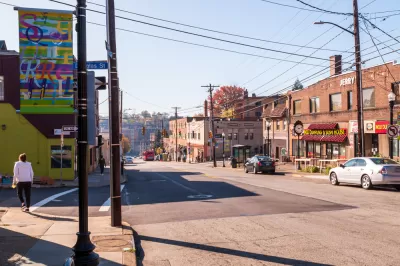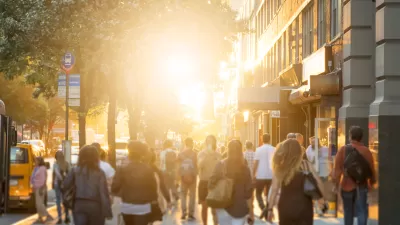A Trulia feature offers lots of interesting information about neighborhoods (or at least about how their residents perceive them).

Last week, Planetizen published a list of interesting planning-related websites—so I thought I would share the most interesting site I discovered this year: Trulia’s neighborhood overview polls. If you go to the real estate side Trulia and put a neighborhood name in the search engine, you can find not only real estate listings for that area, but also the results of a survey of Trulia users.
For example, I live in Manhattan’s Murray Hill.* Of the over 100 Trulia users who were willing to answer a survey, 76 percent would walk alone at night, and only 19 percent think a car is necessary. But only 25 percent say neighbors are friendly, and only 24 percent say there are community events. (In my opinion, all of these statements are completely accurate!) By contrast, in downtown Cleveland (where I lived 23 years ago), 59 percent of people would walk alone at night, and the same percentage say a car is needed. Based on this, one might divide American city neighborhoods into several categories:
*Pedestrian paradises. In the nicer parts of our nation’s most transit-friendly cities, the overwhelming majority of people say that it is safe to walk alone at night, and equally overwhelming majorities feel comfortable without a car. Murray Hill is an excellent example, but these neighborhoods also exist in intown areas of a few other cities. For example, in Philadelphia’s Rittenhouse area on the west side of downtown, 84 percent would walk alone at night, and only 20 percent need a car. And in San Francisco’s Nob Hill the comparable numbers are 74% and 24%.
*In-between cities. In cities with more crime and/or less public transit than New York or Philadelphia, even the most urban neighborhoods have middling percentages of people willing to walk alone at night, either because of higher crime or because their neighborhoods are simply are less busy after dark. And because public transit in these neighborhoods is just so-so, more people think they need cars. Downtown Cleveland (discussed above) is a fine example. Similarly, in St. Louis’s Central West End (where I lived 30 years ago) 49 percent feel comfortable walking at night and 59 percent claim to need a car. This sort of neighborhood is not limited to the Rust Belt: in Midtown Houston, 52 percent feel comfortable walking at night and 64 percent say a car is necessary.
*Working-class outer neighborhoods. Neighborhoods where people feel equally comfortable on their feet and without cars are not limited to Rust Belt and Sun Belt downtowns. In (mostly) working-class areas at the outer edges of transit-oriented cities, people feel more comfortable walking at night than in the most dangerous areas, but less comfortable without a car than downtown residents. In the Northeast Bronx’s Williamsbridge, for example, 49 percent feel safe walking at night and 46 percent say a car is necessary.
*Suburban sprawl. In these suburban parts of town, people feel safe but they need cars. For example, in Jacksonville, Florida’s Pickwick (where I lived a decade ago) 81 percent would walk alone at night but 70 percent need a car. And in Mandarin just to its south, 70 percent would walk alone at night and 86 percent need a car.** Similarly, in Chicago’s Mount Greenwood (at the city’s far southeastern edge) 76 percent say a car is necessary and 82 percent would walk alone at night.
*The worst of both worlds. In the most dangerous urban neighborhoods, fewer than 30 percent of people will walk alone at night, but because walking feels so dangerous, a majority of people say a car is needed. For example, in Chicago’s North Lawndale, 23 percent will walk alone at night and 69 percent say a car is needed. And in Cleveland’s Glenville, only 19 percent will walk alone at night and 75 percent say a car is needed.
*Actually, I think I live in Midtown, but Trulia thinks Midtown begins three blocks north of where I live.
**You might ask, why is there a difference between these neighborhoods? Since Trulia surveys are a) unscientific and b) have sample sizes smaller than a reliable poll, I am pretty sure that these differences are too small to be statistically significant.

Maui's Vacation Rental Debate Turns Ugly
Verbal attacks, misinformation campaigns and fistfights plague a high-stakes debate to convert thousands of vacation rentals into long-term housing.

Planetizen Federal Action Tracker
A weekly monitor of how Trump’s orders and actions are impacting planners and planning in America.

San Francisco Suspends Traffic Calming Amidst Record Deaths
Citing “a challenging fiscal landscape,” the city will cease the program on the heels of 42 traffic deaths, including 24 pedestrians.

Defunct Pittsburgh Power Plant to Become Residential Tower
A decommissioned steam heat plant will be redeveloped into almost 100 affordable housing units.

Trump Prompts Restructuring of Transportation Research Board in “Unprecedented Overreach”
The TRB has eliminated more than half of its committees including those focused on climate, equity, and cities.

Amtrak Rolls Out New Orleans to Alabama “Mardi Gras” Train
The new service will operate morning and evening departures between Mobile and New Orleans.
Urban Design for Planners 1: Software Tools
This six-course series explores essential urban design concepts using open source software and equips planners with the tools they need to participate fully in the urban design process.
Planning for Universal Design
Learn the tools for implementing Universal Design in planning regulations.
Heyer Gruel & Associates PA
JM Goldson LLC
Custer County Colorado
City of Camden Redevelopment Agency
City of Astoria
Transportation Research & Education Center (TREC) at Portland State University
Jefferson Parish Government
Camden Redevelopment Agency
City of Claremont





























